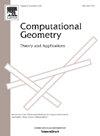Growth rates of the number of empty triangles and simplices
IF 0.7
4区 计算机科学
Q4 MATHEMATICS
Computational Geometry-Theory and Applications
Pub Date : 2025-04-17
DOI:10.1016/j.comgeo.2025.102197
引用次数: 0
Abstract
Given a set P of n points in , in general position, denote by the number of empty triangles with vertices in P. In this paper we investigate by how much changes if a point x is removed from P. By constructing a graph based on the arrangement of the empty triangles incident on x, we transform this geometric problem to the problem of counting triangles in the graph . We study properties of the graph and, in particular, show that it is diamond-free. This relates the growth rate of the number of empty triangles to the famous Ruzsa–Szemerédi problem. We also derive similar bounds for the growth rate of the number of empty simplices for point sets in .
空三角形和单形的数量增长率
给定R2中n个点的集合P,在一般位置上,用N2(P)表示P中有顶点的空三角形的个数。本文研究如果从P中移出一个点x, N2(P)的变化量。通过构造一个图G2(x,P),我们将这个几何问题转化为图G2(x,P)中三角形的计数问题。我们研究了图G2(x,P)的性质,特别是证明了它是无金刚石的。这将空三角形数量的增长率与著名的ruzsa - szemerzedi问题联系起来。我们也为Rd中点集的空简单数的增长率导出了类似的界。
本文章由计算机程序翻译,如有差异,请以英文原文为准。
求助全文
约1分钟内获得全文
求助全文
来源期刊
CiteScore
1.60
自引率
16.70%
发文量
43
审稿时长
>12 weeks
期刊介绍:
Computational Geometry is a forum for research in theoretical and applied aspects of computational geometry. The journal publishes fundamental research in all areas of the subject, as well as disseminating information on the applications, techniques, and use of computational geometry. Computational Geometry publishes articles on the design and analysis of geometric algorithms. All aspects of computational geometry are covered, including the numerical, graph theoretical and combinatorial aspects. Also welcomed are computational geometry solutions to fundamental problems arising in computer graphics, pattern recognition, robotics, image processing, CAD-CAM, VLSI design and geographical information systems.
Computational Geometry features a special section containing open problems and concise reports on implementations of computational geometry tools.

 求助内容:
求助内容: 应助结果提醒方式:
应助结果提醒方式:


